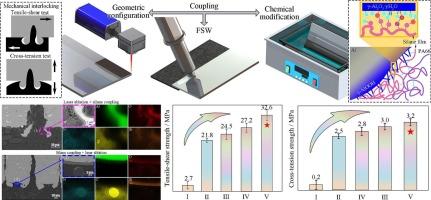界面硅烷膜和激光织构对Al/CFRTP搅拌摩擦焊接接头连接特性的协同作用
IF 7.9
2区 材料科学
Q1 MATERIALS SCIENCE, MULTIDISCIPLINARY
引用次数: 0
摘要
在低空经济轻量化需求的驱动下,为了优化铝合金与碳纤维增强热塑性塑料(CFRTPs)之间的搅拌摩擦焊接接头,开发了一种激光烧蚀-硅烷协同耦合工艺,重点阐明了顺序依赖的梯度界面连接机制。采用激光烧蚀前的硅烷偶联序列,实现了界面几何构型和化学键的双模增强。激光烧蚀区的机械联锁得到了保证,而未烧蚀区的化学键合能力得到了增强。节理抗拉抗剪强度为32.6 MPa,交叉抗拉强度为3.2 MPa。详细的微观结构表征表明,PA66树脂的激光烧蚀区发生了机械互锁,并且通过共价Al-O-Si键与未烧蚀区分子链缠结/氢键的耦合实现了协同的物理化学增强。通过非晶硅烷薄膜对纳米层状结构的渗透,证实了无缺陷的连续界面转变。这种协同策略为异种金属和聚合物材料的高性能连接提供了新的见解。本文章由计算机程序翻译,如有差异,请以英文原文为准。

Synergistic effect of interfacial silane film and laser texturing on joining characteristics of pretreated Al/CFRTP friction stir welded joints
Driven by lightweight requirements in the low-altitude economy, a synergistic laser ablation‒silane coupling process was developed to optimize friction stir welded joints between Al alloys and carbon fiber-reinforced thermoplastics (CFRTPs), with a focus on elucidating the sequence-dependent gradient interfacial joining mechanism. A sequence involving silane coupling prior to laser ablation was employed, enabling dual-mode enhancement of the interfacial geometric configuration and chemical bonding. Mechanical interlocking was ensured in laser-ablated zones, whereas the chemical bonding capacity in unablated regions was enhanced. The tensile–shear strength and cross-tension strength of the joints were measured at 32.6 MPa and 3.2 MPa, respectively. Detailed microstructural characterization revealed that mechanical interlocking occurred in the laser-ablated zones of the PA66 resin and that synergistic physicochemical reinforcement was achieved via covalent Al‒O‒Si bonds coupled with molecular chain entanglement/hydrogen bonding in unablated regions. Defect-free continuous interfacial transitions were confirmed through the penetration of nanolamellar structures by amorphous silane films. This synergistic strategy provides new insights for the high-performance joining of dissimilar metal and polymer materials.
求助全文
通过发布文献求助,成功后即可免费获取论文全文。
去求助
来源期刊

Materials & Design
Engineering-Mechanical Engineering
CiteScore
14.30
自引率
7.10%
发文量
1028
审稿时长
85 days
期刊介绍:
Materials and Design is a multi-disciplinary journal that publishes original research reports, review articles, and express communications. The journal focuses on studying the structure and properties of inorganic and organic materials, advancements in synthesis, processing, characterization, and testing, the design of materials and engineering systems, and their applications in technology. It aims to bring together various aspects of materials science, engineering, physics, and chemistry.
The journal explores themes ranging from materials to design and aims to reveal the connections between natural and artificial materials, as well as experiment and modeling. Manuscripts submitted to Materials and Design should contain elements of discovery and surprise, as they often contribute new insights into the architecture and function of matter.
 求助内容:
求助内容: 应助结果提醒方式:
应助结果提醒方式:


